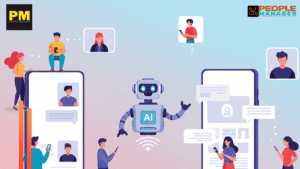HRIS Trends That Are Shaping CHRO’s Success in 2024
HR technology is at a trending time right now. Now let's examine some of the innovative HR practices and technologies that are spearheading the digital transformation of HR.

The majority of organizations require an efficient HR department in order to prosper, expand, and turn a profit. That department might only have one or two workers in small businesses. HR departments in larger businesses often employ more than 5,000 people.
But be clear about it. Managing critical HR procedures is a never-ending task for HR managers, regardless of the size of the workforce. Employees may look for work elsewhere if major HR tasks like payroll processing, onboarding, offboarding, and benefits administration are not completed on a daily basis.
For this reason, companies are using HR technology solutions to make HR procedures go more smoothly. According to projections, the market for human resource management will expand by 12.7% a year between 2023 and 2030, reaching $56 billion. The digitalization of automation, cloud-based platforms, mobile HR apps, and data analytics is driving growth, boosting productivity, and extending capabilities.
HR technology is at a trending time right now. Now let’s examine some of the innovative HR practices and technologies that are spearheading the digital transformation of HR.
HRIS Trends
Since HRIS is a technological function by definition, it usually advances in tandem with other new technological advancements. We’ll go over some HR trends and learn about the newest technology in this section.
1. AI-driven HRIS
Artificial intelligence (AI) is becoming a significant and practical technology to simplify HR operations, despite its frequently dramatic portrayal. AI can be very effective in automation, given the right conditions. AI’s use will only grow as it gets more proficient at labor-intensive jobs (like payroll processing and HR data entry).
AI chatbots can assist in delivering data to HR teams and informing employees. While human oversight is still required, AI may be able to assist in parsing the resumes of potential employees for relevant training and experience with the right setup and application. AI innovation in HR tech will continue to grow, and organizations will profit from it.
2. Using generative AI
Though they are still developing, generative AI technologies like ChatGPT have the potential to offer a wealth of useful capabilities in the future. They could be of assistance with:
- Writing first drafts of job descriptions
- Creating copy for recruitment marketing
- Offering interview questions based on expected knowledge
- Writing forms, letters, and emails
- You can even ask them to help you write AI search queries
- In the long run, generative AI is expected to improve and become even more useful to HR departments. This, with appropriate controls in place, will increase effectiveness and help reduce labor loads.
3. Mobile-first HRIS
Software that is mobile-first is created mostly with mobile devices in mind. More and more customers are choosing to utilize their smartphones or tablets to access HR systems, which is driving this trend. It enables staff members to manage standard HR duties from any location, including time off requests, benefit enrollment, and performance reviews.
In the future, more designs will prioritize mobile devices to accommodate our growing dependence on them. Not just for workers, but also for HR personnel. Through improved interfaces and specialized apps, anybody can access HRIS services on mobile devices at any time or location.
Workers who are on the road can manage other HR duties, seek time off, sign documents, and keep track of their hours worked. Easy access is particularly advantageous for HR workers who are on the go, operate remotely, or have on-site or after-hours HR requirements.
4. Making HRIS more user-friendly
Employees and HR personnel can easily navigate, find it handy, and use an HRIS that is straightforward to use. HRIS suppliers are striving to enhance the user interface (UI) and user experience (UX) since this is no longer a luxury. The system is designed with an emphasis on clear, intuitive features and designs, allowing users to operate it efficiently with no training.
Less time is spent scheduling time to watch videos in a conference room or participating in group onboarding sessions. All information is combined into an accessible and user-friendly employee interface in a straightforward HR software suite. All workers profit from the advancements, regardless of their position or level.
Additionally, employees are more likely to complete HR activities on time when the HRIS is easier to use. Since fewer calls to tech assistance may occur, it’s usually easier for IT teams as well. This expedites HR processes and frees up IT to work on other projects. One example of how user-friendliness is being incorporated into other strategic HR objectives is this win-win situation.
5. Increasing use of HR data
Analysis of predictive data has also grown in importance as an HRIS capability. Machine-learning artificial intelligence (AI) doesn’t mind sorting through tens of thousands of HR data records to uncover relevant trends, unlike the ordinary person. There are various uses for data analysis:
- Using your team’s prior performance and shortcomings as a guide, recommend the best use for their assignments.
- Find out which business projects are most successful and yield valuable benefits.
- Assist in determining whether a worker is considering quitting, possibly with 95% accuracy
- Make reports based on the usage of sick leave, vacation time, personal time, and work-related injuries by your employees.
HRIS will have access to additional data as business systems become more integrated in the future. AI-powered HR analytics are able to identify more patterns and provide superior analysis and solutions since they have access to more data digitally.
6. Automation to help with compliance concerns
HR regulations demand that companies abide by a number of intricate guidelines that require constant attention. This is what motivates the automation of several HRIS capabilities. These features could include keeping an eye out for regulations and guidelines pertaining to employment, protecting user privacy, and keeping audit trails.
HRIS can assist in resolving a number of issues by automating and simplifying document management and HR procedures. Administrative staff can receive automated reminders reminding them of impending audits, modifications, and deadlines. Similarly, employees can receive automatic reminders reminding them to check and update their data. Additional employee self-service services offered by HRIS include knowledge bases, HR best practices, learning and development training, and FAQs. Every day, the list becomes longer.
7. Using exposed API connections
Applications from outside the company can communicate with HRIS systems because of the open application programming interface (API) in HRIS. This gives enterprises the flexibility they need to alter their platforms. Businesses can streamline operations by connecting to external or internal systems or by adding new features thanks to these integrated APIs.
Access to APIs has significantly accelerated the development of contemporary HR software. In the future, HR departments might be on the lookout for more APIs that are used to combine various systems, allowing information to be exchanged and synchronized between independent apps. For instance, to conduct background checks on potential hires, a hiring platform employs an API to sync candidate data with the background check provider. Efficiency may increase even further as systems become increasingly integrated.
8. LCNC platforms (Low-Code/No-Code)
The development and deployment of application software with little to no manual coding is made possible by LCNC platforms. This lessens reliance on hiring developers by enabling non-technical people to construct applications. This trend enables customers to design or alter their own HR software solutions in accordance with their particular needs.
HR departments are saving money and time on development thanks to the LCNC. Spreadsheets that are clumsy and difficult to use can become effective workflows. HR departments will still find it simple to construct surveys, hiring apps, analytic dashboards, and other tools with the assistance of LCNC.
9. Integration and expansion beyond HRIS
There is a growing trend in the market for HRIS integration with other enterprise systems, including project management, accounting, payroll, and enterprise resource planning (ERP). Platforms will keep growing well beyond essential HR procedures like performance monitoring, learning management, employee engagement, and onboarding. It is probable that HR service delivery solutions will develop into an all-in-one platform for employee lifecycle management.
HRIS systems were previously run independently of other business software programs. This might have resulted from perceptions that personnel analytics offered little business intelligence and had little effect on revenue. However, that is evolving. Planning inside the organization now heavily depends on HR analytics related to hiring, tenured vs. new hire ratios, and other KPIs. As we previously discussed, certain emerging tools have the ability to accurately forecast when an employee will think about quitting. As databases are automatically examined by AI platforms and cross-linked, breakthroughs in strategic HR will persist.
HRIS systems will be much more important to companies in the future. Platform growth and integration with data security in mind have advantages, and it is anticipated that businesses will integrate their HR information systems into larger corporate infrastructures.
Read more HR news like this on PropleManager.co.in

Value our content… contribute towards our growth. Even a small contribution per month would be of great help to us. Since our establishment, we have been serving the industry through daily news and updates.
Our content is free for all, and we plan to keep it that way
Support the People Manager. Pay Here
- 𝐕𝐢𝐫 𝐁𝐡𝐚𝐫𝐚𝐭 𝐓𝐚𝐤𝐞𝐬 𝐎𝐧 𝐭𝐡𝐞 𝐌𝐚𝐧𝐝𝐚𝐭𝐞 𝐨𝐟 𝐒𝐞𝐜𝐫𝐞𝐭𝐚𝐫𝐲, 𝐍𝐇𝐑𝐃𝐍 𝐃𝐞𝐥𝐡𝐢 & 𝐍𝐂𝐑 𝐂𝐡𝐚𝐩𝐭𝐞𝐫 𝐟𝐨𝐫 𝟐𝟎𝟐𝟓–𝟐𝟎𝟐7 - December 6, 2025
- Suvarna Nikam On How AI-First Campaigns are Reinventing Employee Experience? - November 28, 2025
- How Siemens India is redefining workforce transformation by embedding HR at the strategic core ? - October 28, 2025









